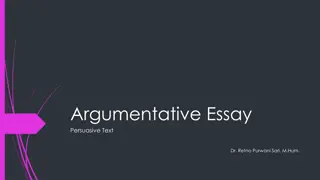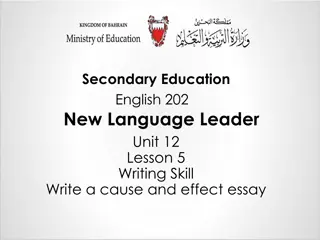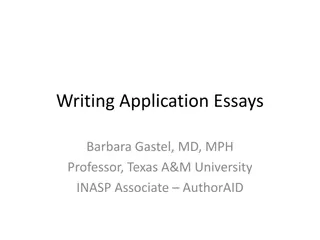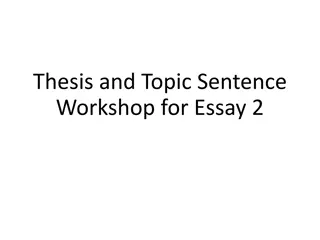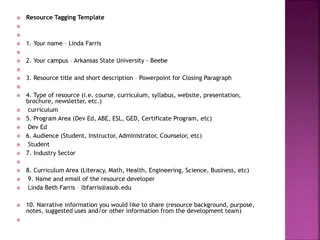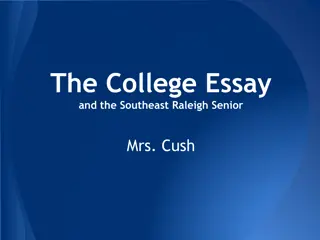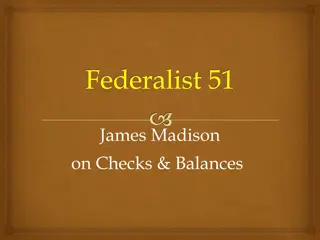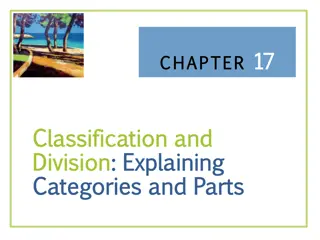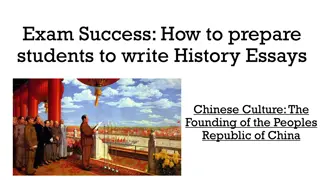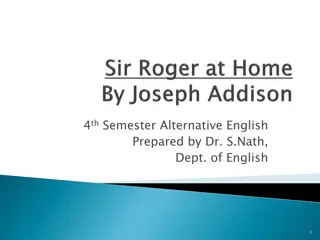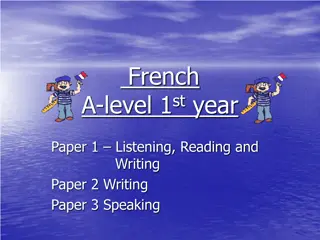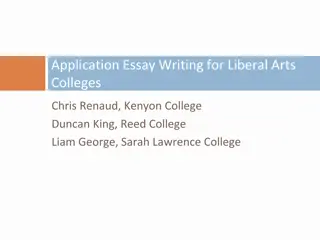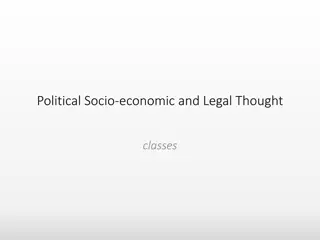
Effective Essay Writing Structures and Styles
Learn about different essay-writing structures, writing styles, and common writing mistakes to avoid for producing high-quality essays. Explore the significance of concise writing, proper use of evidence, and avoiding pretentious language.
Uploaded on | 0 Views
Download Presentation

Please find below an Image/Link to download the presentation.
The content on the website is provided AS IS for your information and personal use only. It may not be sold, licensed, or shared on other websites without obtaining consent from the author. Download presentation by click this link. If you encounter any issues during the download, it is possible that the publisher has removed the file from their server.
E N D
Presentation Transcript
Structure of essay In general, two essay-writing structures Adversarial. Long to short term factors. Marxist or culturalist approach?
Paragraph 1 point = 1 paragraph No more than 250 words PEEL Topic sentence 3 varied pieces of evidence No linking sentence
Writing style. In general follow George Orwell, Politics and the English Language 1.Never use a metaphor, simile, or other figure of speech which you are used to seeing in print. 2.Never use a long word where a short one will do. 3.If it is possible to cut a word out, always cut it out. 4.Never use the passive where you can use the active. 5.Never use a foreign phrase, a scientific word, or a jargon word if you can think of an everyday English equivalent. 6.Break any of these rules sooner than say anything outright barbarous.
Or Vigorous writing is concise. A sentence should contain no unnecessary words, a paragraph no unnecessary sentences, for the same reason that a drawing should have no unnecessary lines and a machine no unnecessary parts. This requires not that the writer make all his sentences short, or that he avoid all detail and treat his subjects only in outline, but that every word tell. William Strunk Jr. in The Elements of Style
Pretentious use of adjectives/overuse of the thesaurus. Between April 1846 and February 1848, Mexico and the neighbouring United States would engage in a prolonged and vicious war of attrition to decide the fate of Mexico s northernmost territories. The dominant victory of the infant United States forever bolstered its geographical, economic and military status as an emerging nation, but also established a precedent of colonial expansionism (both physical and ideological) which would facilitate its transition into the globe s predominant cultural force. In contrast, Mexico s severe bereavement surrounding loss of land and collective embarrassment regarding such a blatant violation of its independence, would be subsumed below its northern counterpart.
The long, confusing sentence that contains multiple points James Polk s goal to Manifest Destiny was the ideological push for America to invade the independent state of Texas in 1846, using the occupation as a way of negotiating the Treaty of Guadalupe Hidalgo in 1848 and claiming the northern territory Polk was after, whilst also, as Peter Guardino points out, promoting strong anti-Catholic and anti-Mexican motivations for volunteer soldiers, who would go on to impose terror on peaceful Mexicans and Catholicism in general, continuing to do so throughout Texas, California, and New Mexico. The most common historical perspective leans towards the notion that Mark Wasserman put forward whereby Mexico was severely wounded by the failures from Mexican political institutions and this was fundamentally fueled by the underlying property differences between the rich Spanish colonial elite and the poorer indigenous residents resulting in vast economic disparity
The hanging or dangling clause There is often disagreement surrounding the events of the Mexican independence movement, most notably which factors catalysed the break from Spanish imperial rule and allowed the rebellion to gain such widespread support in the 1800s. Or While American expansionism is the most important cause of the war, Polk s actions are important in causing the outbreak of war, serving as a trigger.
Absence of main verbs Mexico s loss of Texas suggested that Mexico was a second-class country, unable to effectively organise its territory. Now no longer an equal who could colonise, but one to be colonised, placing them on par with Native Americans in US eyes Or Therefore, slavery as a motivating factor behind expansionism drove the US to ignite the acquisition of territory, in this example Texas. Which increased war into a possibility over a mere probability. Or The Mexican cause as, political tensions driven by their undiplomatic behaviour, including their treatment of Americans before the war, which aggravated American governments. Therefore, this essay will consider the traditional, historical arguments of Texas and territory, and assess where slavery can fit into questions of expansionism. Followed by critical analysis of the significance of Mexican involvement as a cause of the war.
Pointless signposting Thus, it is clear that the cultural divisions were fundamental in causing civil turmoil as aspects of culture like religion were essential to all sectors of Mexican society which brought forward other disparities. Firstly, the instruments of colonial rule and the governance of New Spain must be looked at in order to understand the reasons for Mexican independence. In consideration of the historical contributions to the discussion of the Mexican-American war it is explicit that the annexation of Texas, advocated by the Americans was the number one cause of the war.
Some tricks of the trade. Formal grammatical or stylistic rules are there to be broken Keep topic sentences short (rarely more than a line or two long). The semicolon e.g. Some took up arms and joined left-wing guerrilla insurgencies; others fled to find uncertain but slightly better paid work in the cities; others, still, fled up to the United States. The use of And and But at the beginning of a sentence. Bathos occasionally slang or flippant phrasing. Downbeat or cynical humor But others turned to drug growing. It was and still is the opposite of white-collar weed smuggling. It was not a choice; it was a necessity. And perhaps even more than guerilla insurgency or mass outmigration, it would shape Mexican peasant relations with the outside world for the next fifty years. And unlike dying in abject poverty, it actually attracted the attention of the Mexican and U.S. governments.
Evidence Mix types of evidence Avoid quoting historians unless it is a particularly evocative quote. Use contemporary quotations Use quantitative evidence. Make up your own cottage cliometrics . Use small stories or anecdotes
In the book The Dead March by Peter Guardino we see the ideas of religious persecution and fear of Catholicism as a fundamental reason of why the US expanded into Mexican territory. Guardino argues that America saw Catholicism as positively threatening with the Church being too hierarchical to be compatible with democracy .[1] This belief that the Catholics were anti American often led to deep anti-Catholic sentiments within America itself with this clearly being demonstrated in the existence of the San Patricio s who saw more in common with Mexicans due to their shared religion than the American s who repeatedly harassed and abused them. This relates even deeper to the war when the belief became popular that the Catholic church was encouraging this migration to undermine the United States .1 People believed that Catholicism was infecting their nation from abroad and Peter Guardino argues that the violent backlash against this increased immigration was as much anti-Catholic as it was anti-foreign .1 This suggests that the war into Mexico was clearly tied to religious sentiments held by those in America as we see a growing belief that the immigration from this country was undermining its values. Historians such as Ted C. Hinckley have called this a protestant crusade [2] and by 1845 Mexico became the most common example used to prove Catholicism s detrimental effects on the mind and soul .[3] This demonstrates the strongly held view that the eradication of Catholicism or at least the minimising of the impact of Catholicism on American society was a key influence on America wanting to enter the conflict. This would depict a society wherein a war with a deeply Catholic nation would be mandated by the population as Hinckley points out we can see beliefs at the time that without conflict the yoke of papal oppression would be placed upon every state of this republic .[4] This clearly demonstrates the significance of religion to the war and that without religion this conflict may not have taken place. However, Guardino s suggestion that Polk was seeking to take advantage of a neighbouring country whose political and economic weakness he despised and whose possessions he converted may demonstrate the greater significance of external factors on the conflict


